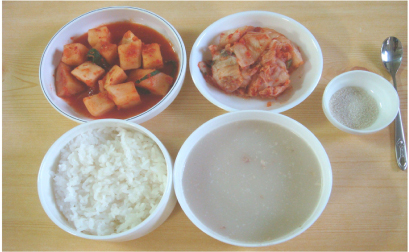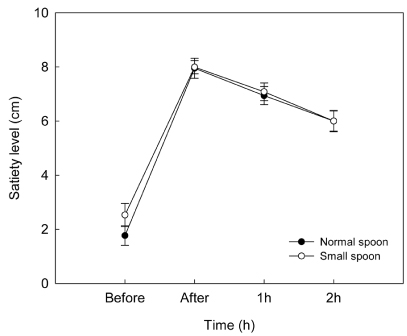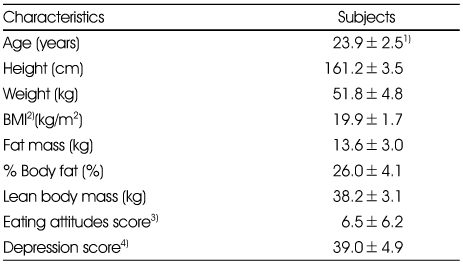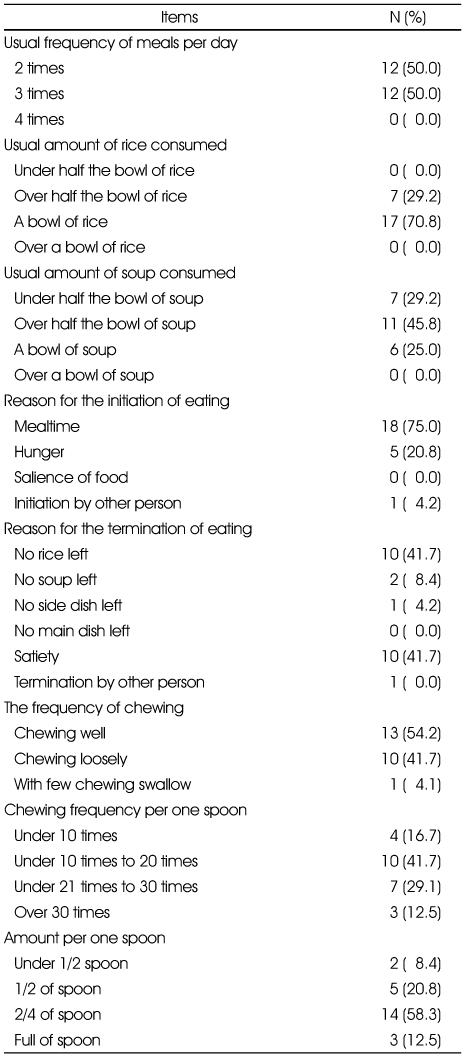Articles
- Page Path
- HOME > Korean J Community Nutr > Volume 20(5); 2015 > Article
-
Research Article
- Influence of the Size of the Spoon on the Eating rate, Energy Intake and the Satiety Levels of Female College Students
- Yang Hee Hong, Young Suk Kim, Hyun Jung Kwon, Do Seok Chang, Dong Geon Kim, Un Jae Chang
-
Korean Journal of Community Nutrition 2015;20(5):375-382.
DOI: https://doi.org/10.5720/kjcn.2015.20.5.375
Published online: October 31, 2015
1Department of Beauty Art, Suwon Women's University, Suwon, Korea.
2Department of Food and Nutrition, Ansan University, Ansan, Korea.
3Department of Food and Nutrition, Dongduk Women's University, Seoul, Korea.
4Department of Statistics and Information, Dongduk Women's University, Seoul, Korea.
- Corresponding author: Un Jae Chang. Department of Food and Nutrition Dongduk Women's University, 60 Hwarang-ro 13-gil, Seongbuk-gu, Seoul 02748, Korea. Tel: (02) 940-4464, Fax: (02) 940-4609, uj@dongduk.ac.kr
Copyright © 2015 The Korean Society of Community Nutrition
This is an Open-Access article distributed under the terms of the Creative Commons Attribution Non-Commercial License (http://creativecommons.org/licenses/by-nc/3.0/) which permits unrestricted non-commercial use, distribution, and reproduction in any medium, provided the original work is properly cited.
- 401 Views
- 1 Download
Abstract
-
Objectives
- This study examined the influence of different sizes of spoons (normal spoon, 8.3 cc vs small spoon, 4 cc) on eating rate, energy intake and the satiety levels of female college students.
-
Methods
- Twenty four healthy female college students participated in this study once a week for 2 weeks. Two hundred ten grams of cooked rice and 250 g of beef shank soup with a normal spoon and same amount of rice and soup with a small size spoon were served to the same participants over two consecutive weeks. After each lunch, the eating rate, energy intake, and the satiety levels were measured.
-
Results
- Results showed that the subjects who were using a small spoon ate less beef shank soup (149.0 kcal) (p < 0.01) and had lower total energy intake (423.3 kcal) (p < 0.05) than using a normal spoon (178.7 and 461.1 kcal, respectively). Also, the meal time (15.7 min) (p < 0.01), a serving per one spoon (8.6 g) (p < 0.001), and eating rate (27.9 g/min) (p < 0.001) of those who used a small spoon were significantly different than that of those who used a normal spoon (13.6 min, 12.5 g and 35.7 g/min, respectively). However, despite consuming less energy at lunch, the level of satiety after eating from the small spoon was not significantly different from the normal spoon immediately after, 1 hour after and 2 hour after lunch.
-
Conclusions
- Our results revealed that students were able to control their eating rate by using a small spoon and they could feel full enough even though they eat less. In conclusion, eating rate decrease by using a small spoon may play an important role in food intake.
- 1. Baek YA, Kim KN, Lee YA, Chang NS. The effect of nutrition education on visceral fat reduction and diet quality in postmenopausal women. Korean J Nutr 2008; 41(7): 634-644.
- 2. Hill MJ, Metcalfe D, McTernan PG. Obesity and diabetes: lipids, nowhere to run to. Clin Sci 2009; 116(2): 113-123.ArticlePDF
- 3. Wansink B. Environmental factors that increase the food intake and consumption volume of unknowing consumers. Annu Rev Nutr 2004; 24: 455-479.ArticlePubMed
- 4. Cho KO, Jeong SY. The effects of regular dietary habits on obesity indices and nutrition intakes in adult males. J Korean Diet Assoc 2007; 13(2): 114-122.
- 5. Ahn NY, Hong CB, Kim KJ. Comparison the exercise, diet and lifestyle of obese type in Korean adults. J Sport Leis Stud 2007; 31(2): 657-672.Article
- 6. Yoon GA. Association of obesity with television watching and physical activity in adult female. Korean J Nutr 2003; 36(7): 769-776.
- 7. Kim MK. Serum lipids gender, age and lifestyle in Korean adult. Korean J Community Nutr 2000; 5(1): 109-119.
- 8. Hermann JR, Kopel BH, McCrory ML, Kulling FA. Effect of cooperative extension nutrition and exercise program for older adults on nutrition knowledge, dietary intake, anthropometric measurements and serum lipids. J Nurt Educ 1990; 22(6): 271-274.
- 9. Carnell S, Wardle J. Measuring behavioural susceptibility to obesity: validation of the child eating behaviour questionnaire. Appetite 2007; 48(1): 104-113.ArticlePubMed
- 10. Guertin TL. Eating behavior of bulimics, self-identified binge eaters, and non-eating-disordered individuals: what differentiates these populations? Clin Psychol Rev 1999; 19(1): 1-23.PubMed
- 11. Otsuka R, Tamakoshi K, Yatsuya H, Wada K, Matsushita K, OuYang P. Eating fast leads to insulin resistance: findings in middle-aged Japanese men and women. Prev Med 2008; 46(2): 154-159.ArticlePubMed
- 12. Hill AJ. Obesity and eating disorders. Obes Rev 2007; 8(s1): 151-155.ArticlePubMed
- 13. Sun Y, Sekine M, Kagamimori S. Lifestyle and overweight among Japanese adolescents: the Toyama birth cohort study. J Epidemiol 2009; 19(6): 303-310.ArticlePubMedPMC
- 14. Kimura Y, Nanri A, Matsushita Y, Sasaki S, Mizoue T. Eating behavior in relation to prevalence of overweight among Japanese men. Asia Pac J Clin Nutr 2011; 20(1): 29-34.PubMed
- 15. Lee YS. A study on the eating behavior, nutritional status and health condition of obese adult attending a weight control exercise. Korean J Food Nutr 2000; 13(2): 125-132.
- 16. Wansink B. Can package size accelerate usage volume? J Mark 1996; 60(3): 1-14.ArticlePDF
- 17. Rolls BJ, Roe LS, Meengs JS. Reductions in portion size and energy density of foods are additive and lead to sustained decreases in energy intake. Am J Clin Nutr 2006; 83(1): 11-17.ArticlePubMed
- 18. Wansink B, Van Ittersum K, Painter JE. Ice cream illusions bowls, spoons, and self-served portion sizes. Am J Prev Med 2006; 31(3): 240-243.PubMed
- 19. Van Ittersum K, Wansink B. Do children really prefer large portions? Visual illusions bias their estimates and intake. J Am Diet Assoc 2007; 107(7): 1107-1110.ArticlePubMed
- 20. Wansink B, van Ittersum K. Portion size me: downsizing our consumption norms. J Am Diet Assoc 2007; 107(7): 1103-1106.ArticlePubMed
- 21. Chang UJ, Jung EY, Hong IS. The effect of the reduced portion size by using a diet rice bowl on food consumption and satiety rate. Korean J Community Nutr 2007; 12(5): 639-645.
- 22. Rolls BJ. The role of energy density in the overconsumption of fat. J Nutr 2000; 130(2): 268S-271S.ArticlePubMed
- 23. Garner DM, Garfinkel PE. The eating attitudes test: an index of the symptoms of anorexia nervosa. Psychol Med 1979; 9(2): 273-279.ArticlePubMed
- 24. Zung WW. Prevalence of clinically significant anxiety in a family practice setting. Am J Psychiatry 1986; 143(11): 1471-1472.ArticlePubMed
- 25. Jun SC, Kim YJ, Kim YS, Kim SK, Kim DG, Chang UJ. The relationships of chewing frequency, eating rates, and food consumption with the body mass index and gender of college students. J Korean Diet Assoc 2013; 19(2): 103-111.Article
- 26. Rolls BJ, Morris EL, Roe LS. Portion size of food affects energy intake in normal-weight and overweight men and women. Am J Clin Nutr 2002; 76(6): 1207-1213.ArticlePubMed
- 27. Rolls BJ, Roe LS, Kral TV, Meengs JS, Wall DE. Increasing the portion size of a packaged snack increases energy intake in men and women. Appetite 2004; 42(1): 63-69.PubMed
- 28. Krassner HA, Brownell KD, Stunkard AJ. Cleaning the plate: food left over by overweight and normal weight persons. Behav Res Ther 1979; 17(2): 155-156.PubMed
- 29. Kim HK, Kim MJ. Effects of weight control program on dietary habits and blood composition in obese middle-aged women. Korean J Nutr 2010; 43(3): 273-284.
- 30. Kim S. A study on the relationship between time spent on lunch and degree of obesity, eating habits in culinary college male students. Korean J Community Nutr 2006; 11(6): 695-706.
- 31. Sasaki S, Katagiri A, Tsuji T, Shimoda T, Amano K. Selfreported rate of eating correlates with body mass index in 18-yold Japanese women. Int J Obes Relat Metab Disord 2003; 27(11): 1405-1410.PubMed
- 32. Wang SK. Prevalence of obesity, food habits, and daily nutrient intakes of 4th grade elementary school students in Daejeon. Korean J Hum Ecol 2007; 16(3): 631-631.
- 33. Moon HK, Lee HJ, Park Y. Comparison of health status and dietary habits by percent body fat change for adult women in the weight control program by the community health center. Korean J Community Nutr 2007; 12(4): 477-488.
- 34. Kim SY, Yoon JS. Effects of serum insulin, eating style and energy intake on the fatness. Korean J Nutr 1993; 26(1): 34-46.
- 35. Wansink B. Environmental factors that increase the food intake and consumption volume of unknowing consumers. Annu Rev Nutr 2004; 24: 455-479.PubMed
- 36. Wansink B, Cheney MM. Super bowls: serving bowl size and food consumption. JAMA 2005; 293(14): 1723-1728.PubMed
- 37. Chang UJ, Jo JN. The relationship between food intake, sodium intake and satiety rate and the methods of consuming soup. J Korean Diet Assoc 2009; 15(4): 397-404.
- 38. Andrade AM, Greene GW, Melanson KJ. Eating slowly led to decreases in energy intake within meals in healthy women. J Am Diet Assoc 2008; 108(7): 1186-1191.PubMed
- 39. Li J, Zhang N, Hu L, Li Z, Li R, Li C, Wang S. Improvement in chewing activity reduces energy intake in one meal and modulates plasma gut hormone concentrations in obese and lean young Chinese men. Am J Clin Nutr 2011; 94(3): 709-716.PubMed
- 40. Kim KN, Lee KS. Nutrition knowledge, dietary attitudes, and food behaviors of college students. Korean J Community Nutr 1996; 1(1): 89-99.
REFERENCES
Figure & Data
REFERENCES
Citations




Fig. 1
Fig. 2
Fig. 3
Characteristics of the subjects
1) Mean±SD
2) BMI: Body mass index, body weight (kg) / [height (m)]2
3) Eating Attitudes Test [23]
4) Zung Self-Rating Questionnaire [24]
Usual eating and chewing behavior for the subjects
Energy intake of rice, soup, side dish & total meal from lunch provided by the normal and small spoon
1) Mean±SD
*: p < 0.05, **: p < 0.01 : normal spoon vs. small spoon by paired t-test
Meal time, a serving per one spoon & eating rate from lunch provided by the normal and small spoon
1) Mean±SD
**: p < 0.01, ***: p < 0.001: normal spoon vs. small spoon by paired t-test
1) Mean±SD 2) BMI: Body mass index, body weight (kg) / [height (m)]2 3) Eating Attitudes Test [ 4) Zung Self-Rating Questionnaire [
1) Mean±SD *: p < 0.05, **: p < 0.01 : normal spoon vs. small spoon by paired t-test
1) Mean±SD **: p < 0.01, ***: p < 0.001: normal spoon vs. small spoon by paired t-test

 KSCN
KSCN







 PubReader
PubReader Cite
Cite


